目录
1.数据结构相关概念
1.什么是数据结构
数据结构是由“数据”和“结构”两词组合⽽来。
什么是数据?常⻅的数值1、2、3、4.....、教务系统⾥保存的用户信息(姓名、性别、年龄、学历等。⽹⻚⾥⾁眼可以看到的信息(⽂字、图⽚、视频等等),这些都是数据
2.什么是结构
当我们想要使⽤⼤量使⽤同⼀类型的数据时,通过⼿动定义⼤量的独⽴的变量对于程序来说,可读性⾮常差,我们可以借助数组这样的数据结构将⼤量的数据组织在⼀起,结构也可以理解为组织数据的⽅式。
概念:数据结构是计算机存储,组织数据的方式。数据结构是指相互之间存在一种或多种特定关系的数据元素的集合。数据结构反映数据的内部构成,即数据由那部分构成,以什么方式构成,以及数据元素之间呈现的结构。
总结:
- 能够存储数据(如:顺序表,链表等结构)
- 存储的数据能够方便查找
2.为什么需要数据结构?

【思考】有了数组,为什么还要学习其他的数据结构?假定数组有10个空间,已经使⽤了5个,向数组中插⼊数据步骤:求数组的⻓度,求数组的有效数据个数,向下标为数据有效个数的位置插⼊数据(注意:这⾥是否要判断数组是否满了,满了还能继续插⼊吗).....假设数据量⾮常庞⼤,频繁的获取数组有效数据个数会影响程序执⾏效率。结论:最基础的数据结构能够提供的操作已经不能完全满⾜复杂算法实现。
2.顺序表
2.1 顺序表与数组的区别和联系
- 顺序表的底层结构就是数组。
- 顺序表虽然底层是数组,但提供了很多现成的方法,开箱即用,就变成了一个新的很厉害的数据结构。

顺序表是线性表的一种。
顺序表在物理结构上连续,在逻辑结构上也连续。
线性表:
线性表( linear list )是n个具有相同特性的数据元素的有限序列。 线性表是⼀种在实际中⼴泛使⽤的数据结构,常⻅的线性表:顺序表、链表、栈、队列、字符串...线性表在逻辑上是线性结构,也就说是连续的⼀条直线。但是在物理结构上并不⼀定是连续的,线性表在物理上存储时,通常以数组和链式结构的形式存储。案例:蔬菜分为绿叶类、⽠类、菌菇类。线性表指的是具有部分相同特性的⼀类数据结构的集合如何理解逻辑结构和物理结构?
2.2 顺序表的分类
1.静态顺序表:
struct SeqList
{
int arr[100];
int size//顺序表当前有效数据的个数
}2.动态顺序表:
struct SeqList
{
int *arr;
int size;//有效数据的个数
int capacity;//空间的大小
}2.3 顺序表的实现
创建两个.c文件和一个.h文件
SeqList.h 存放头文件,结构体和函数的声明。
SeqList.c 实现顺序表。
test.c 测试顺序表。
2.3.1初始化
typedef int SLDataType;
typedef struct SeqList
{
SLDataType* arr;
int size;
int capacity;
}SL;先创建动态顺序表,这个顺序表放在SeqList.h头文件中
//初始化
void SLInit(SL* ps)
{
ps->arr = NULL;
ps->capacity = ps->size = 0;
}函数的声明放在SeqList.h中,函数实现放在SeqLish.c中,在test.c中测试
2.3.2 顺序表销毁
void SLDestroy(SL* ps)
{
if (ps->arr)
{
free(ps->arr);
}
ps->arr = NULL;
ps->capacity = ps->size = 0;
}在程序最后要把动态申请的内存释放掉。
2.3.3 尾部插入删除 / 头部插入删除
初始化的时候size和capacity都为0,要插入数据空间不够,所以要先申请空间
//判断capacity的空间够不够
void SLCheckCapacity(SL* ps)
{
assert(ps);//等价于assert(ps!=NULL);
if (ps->capacity == ps->size)
{
int newCapacity = 0;
newCapacity = ps->capacity == 0 ? 4 : 2 * ps->capacity;//三目操作符开辟2倍的有效空间
//开辟空间
SLDataType* temp = (SLDataType*)realloc(ps->arr, newCapacity* sizeof(SLDataType));
//开辟失败
if (temp == NULL)
{
perror("realloc fail");
exit(1);
}
ps->arr = temp;
ps->capacity = newCapacity;
}
}尾插:
void SLPushBack(SL* ps, SLDataType x)
{
SLCheckCapacity(ps);
ps->arr[ps->size] = x;
ps->size++;
}尾插测试:

头插:
void SLPushFront(SL* ps, SLDataType x)
{
assert(ps);
SLCheckCapacity(ps);
for (int i = ps->size; i > 0; i--)
{
ps->arr[i] = ps->arr[i - 1];
}
ps->arr[0] = x;
ps->size++;
}打印代码:
void SLPrintf(SL s)
{
for (int i = 0; i < s.size; i++)
{
printf("%d ", s.arr[i]);
}
printf("\n");
}测试结果
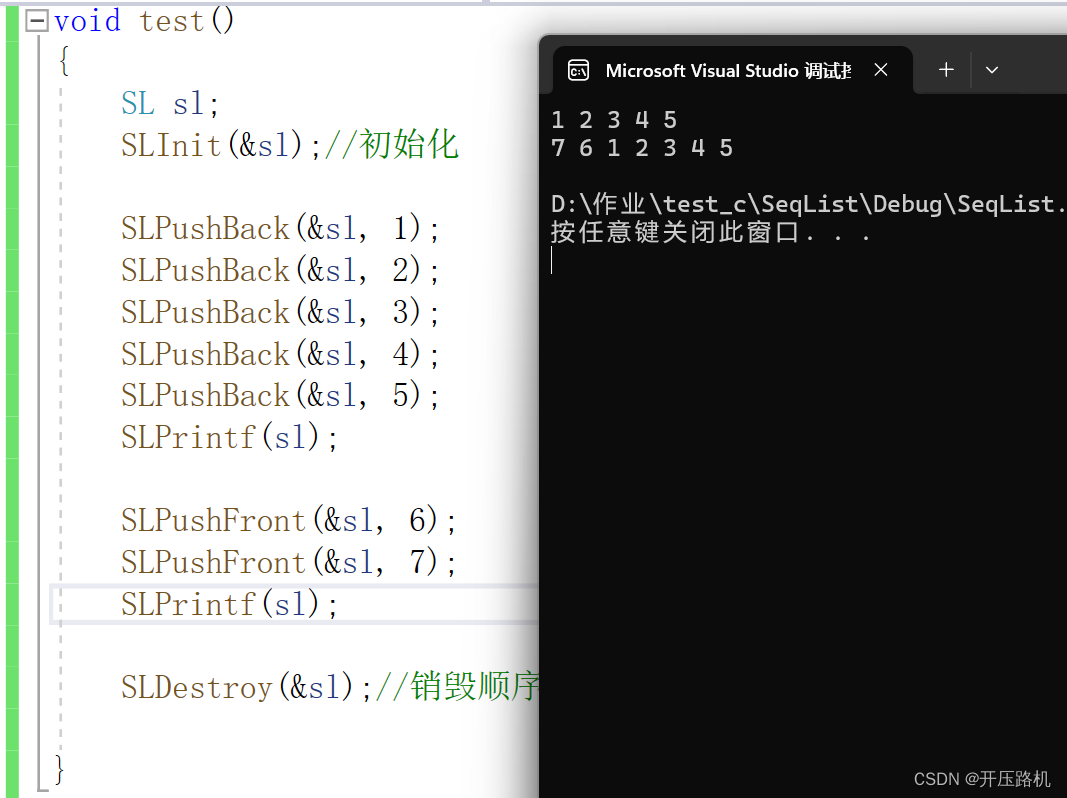
尾删:
void SLPopBack(SL* ps)//尾删
{
assert(ps);
assert(ps->size);//顺序表不能为空
--ps->size;
}尾删测试:
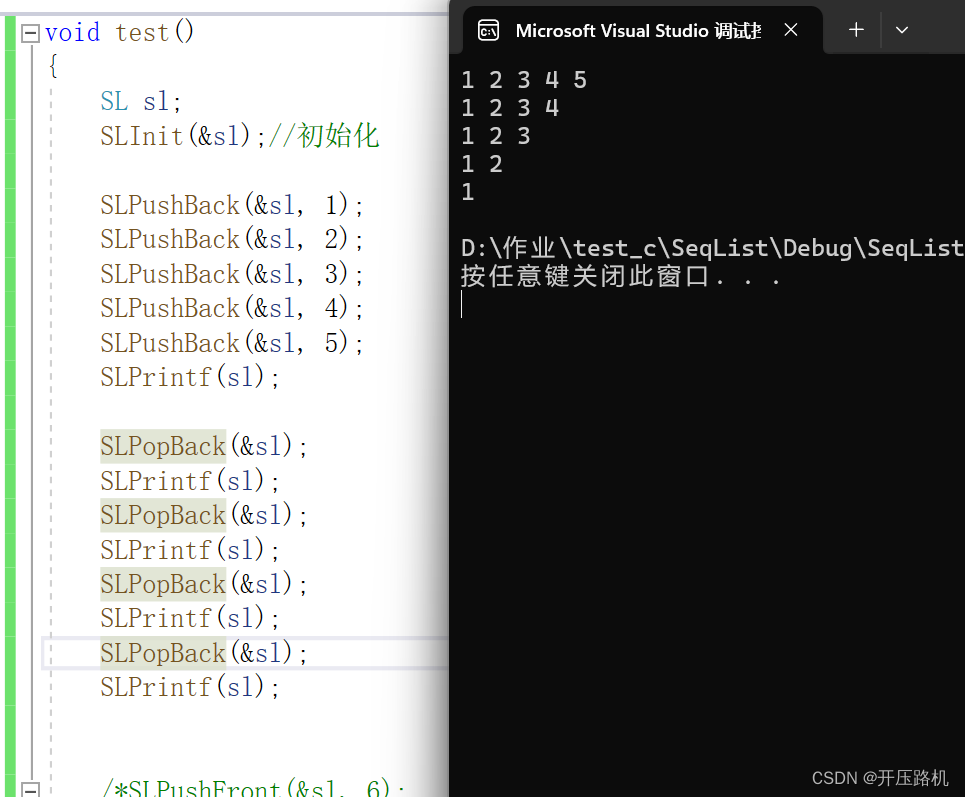
头删:

void SLPopFront(SL* ps)//头删
{
assert(ps);
assert(ps->size);
for (int i = 0; i < ps->size-1; i++)
{
ps->arr[i] = ps->arr[i + 1];
}
ps->size--;
}头删测试:
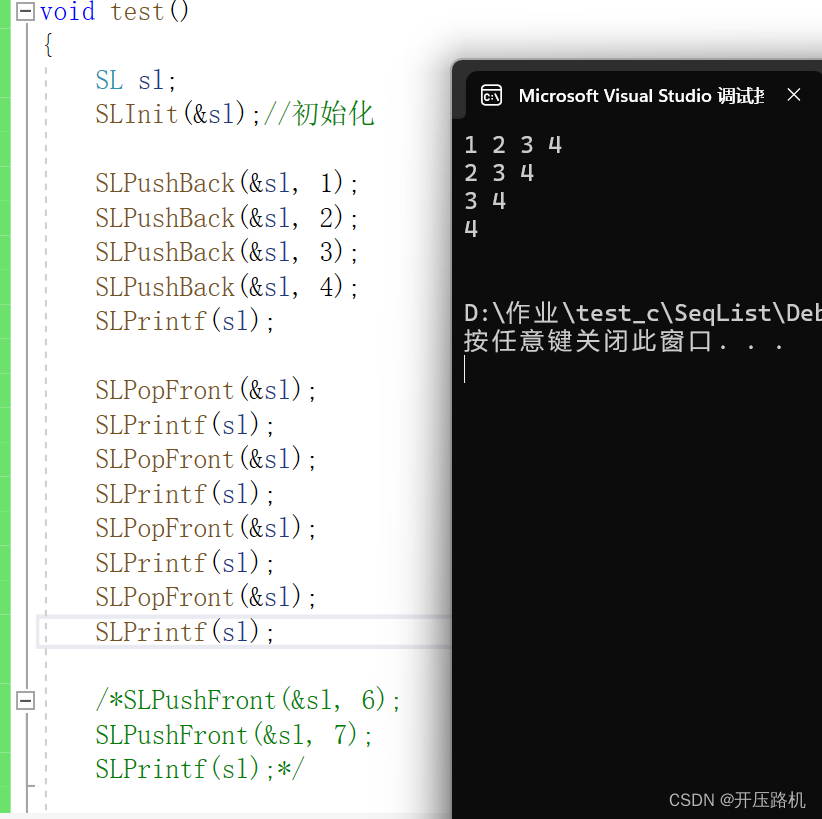
2.3.4 指定位置之前插入数据
//在指定位置之前插入数据
void SLInsert(SL* ps, int pos, SLDataType x)
{
assert(ps);
assert(pos >= 0 && pos <= ps->size);//pos==ps->size时相当于尾插
//插入空间,判断空间是否够不够
SLCheckCapacity(ps);
for (int i = ps->size; i > pos; i--)
{
ps->arr[i] = ps->arr[i - 1];
}
ps->arr[pos] = x;
ps->size++;
}
测试运行代码:
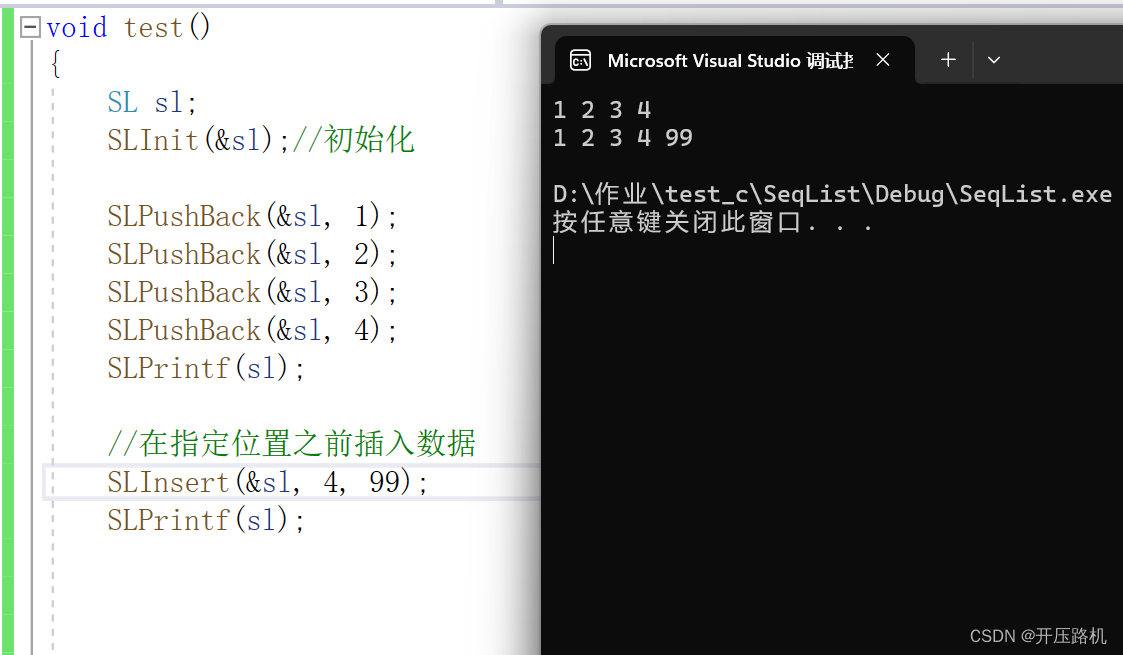
2.3.5 指定位置删除数据
void SLErase(SL* ps, int pos)
{
assert(ps);
assert(pos >= 0 && pos < ps->size);//此时pos不能等于size
for (int i = pos; i < ps->size-1; i++)
{
ps->arr[i] = ps->arr[i + 1];
}
ps->size--;
}
测试运行代码:
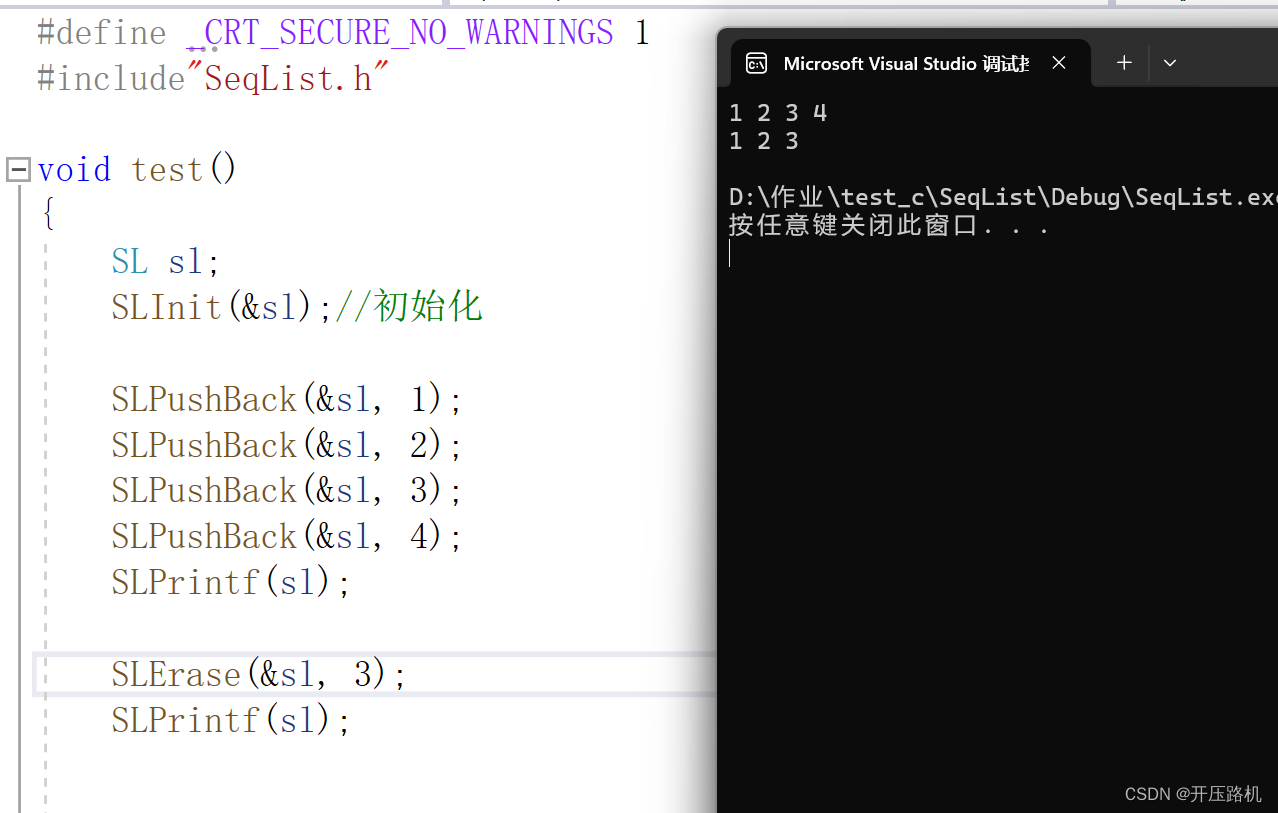
2.3.6 在顺序表中查找
int SLFind(SL* ps, SLDataType x)
{
assert(ps);
for (int i = 0; i < ps->size; i++)
{
if (ps->arr[i] == x)
{
return i;
}
}
return -1;
}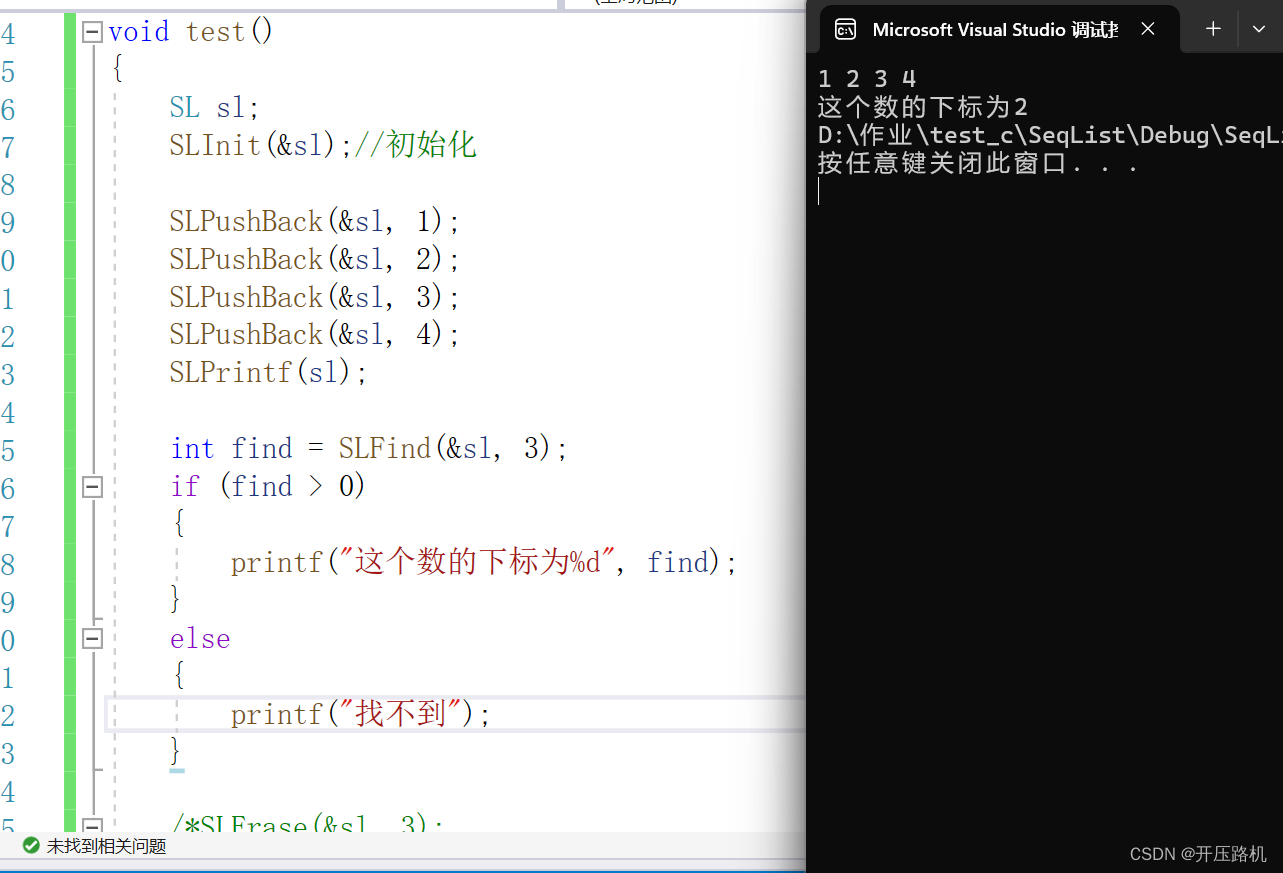
此时顺序表就实现了
SeqList.h
#pragma once
//定义顺序表的结构
#include<stdio.h>
#include<stdlib.h>
#include<assert.h>
//静态顺序表
//struct SeqList
//{
// int arr[100];
// int size;
//};
//动态顺序表
typedef int SLDataType;
typedef struct SeqList
{
SLDataType* arr;
int size;//有效空间数
int capacity;//空间大小
}SL;
void SLInit(SL* ps);//初始化
void SLDestroy(SL* ps); //顺序表的销毁
void SLPrintf(SL s);
//头部插⼊删除 / 尾部插⼊删除
void SLPushBack(SL* ps, SLDataType x);
void SLPopBack(SL* ps);
void SLPushFront(SL* ps, SLDataType x);
void SLPopFront(SL* ps);
//指定位置之前插⼊/删除数据
void SLInsert(SL* ps, int pos, SLDataType x);
void SLErase(SL* ps, int pos);
int SLFind(SL* ps, SLDataType x);
SeqList.c
#include"SeqList.h"
//初始化
void SLInit(SL* ps)
{
ps->arr = NULL;
ps->capacity = ps->size = 0;
}
//顺序表的销毁
void SLDestroy(SL* ps)
{
if (ps->arr)
{
free(ps->arr);
}
ps->arr = NULL;
ps->capacity = ps->size = 0;
}
//判断capacity的空间够不够
void SLCheckCapacity(SL* ps)
{
if (ps->capacity == ps->size)
{
int newCapacity = 0;
newCapacity = ps->capacity == 0 ? 4 : 2 * ps->capacity;
//开辟空间
SLDataType* temp = (SLDataType*)realloc(ps->arr, newCapacity* sizeof(SLDataType));
//开辟失败
if (temp == NULL)
{
perror("realloc fail");
exit(1);
}
ps->arr = temp;
ps->capacity = newCapacity;
}
}
void SLPushBack(SL* ps, SLDataType x)//尾插
{
assert(ps);
SLCheckCapacity(ps);
//ps->arr[ps->size] = x;
//ps->size++;
ps->arr[ps->size++] = x;
}
void SLPushFront(SL* ps, SLDataType x)//头插
{
assert(ps);
SLCheckCapacity(ps);
for (int i = ps->size; i > 0; i--)
{
ps->arr[i] = ps->arr[i - 1];
}
ps->arr[0] = x;
ps->size++;
}
void SLPrintf(SL s)//打印顺序表
{
for (int i = 0; i < s.size; i++)
{
printf("%d ", s.arr[i]);
}
printf("\n");
}
void SLPopBack(SL* ps)//尾删
{
assert(ps);
assert(ps->size);//顺序表不能为空
--ps->size;
}
void SLPopFront(SL* ps)//头删
{
assert(ps);
assert(ps->size);
for (int i = 0; i < ps->size-1; i++)
{
ps->arr[i] = ps->arr[i + 1];
}
ps->size--;
}
//在指定位置之前插入数据
void SLInsert(SL* ps, int pos, SLDataType x)
{
assert(ps);
assert(pos >= 0 && pos <= ps->size);//pos==ps->size时相当于尾插
//插入空间,判断空间是否够不够
SLCheckCapacity(ps);
for (int i = ps->size; i > pos; i--)
{
ps->arr[i] = ps->arr[i - 1];
}
ps->arr[pos] = x;
ps->size++;
}
//在指定位置删除数据
void SLErase(SL* ps, int pos)
{
assert(ps);
assert(pos >= 0 && pos < ps->size);//此时pos不能等于size
for (int i = pos; i < ps->size-1; i++)
{
ps->arr[i] = ps->arr[i + 1];
}
ps->size--;
}
int SLFind(SL* ps, SLDataType x)
{
assert(ps);
for (int i = 0; i < ps->size; i++)
{
if (ps->arr[i] == x)
{
return i;
}
}
return -1;
}test.c
#define _CRT_SECURE_NO_WARNINGS 1
#include"SeqList.h"
void test()
{
SL sl;
SLInit(&sl);//初始化
SLPushBack(&sl, 1);
SLPushBack(&sl, 2);
SLPushBack(&sl, 3);
SLPushBack(&sl, 4);
SLPrintf(sl);
int find = SLFind(&sl, 3);
if (find > 0)
{
printf("这个数的下标为%d", find);
}
else
{
printf("找不到");
}
/*SLErase(&sl, 3);
SLPrintf(sl);*/
//在指定位置之前插入数据
//SLInsert(&sl, 4, 99);
//SLPrintf(sl);
//SLPopFront(&sl);
//SLPrintf(sl);
//SLPopFront(&sl);
//SLPrintf(sl);
//SLPopFront(&sl);
//SLPrintf(sl);
//SLPopFront(&sl);
//SLPrintf(sl);
/*SLPushFront(&sl, 6);
SLPushFront(&sl, 7);
SLPrintf(sl);*/
SLDestroy(&sl);//销毁顺序表
}
int main()
{
test();
return 0;
}3.基于顺序表实现通讯录
通讯录中的信息应该有姓名,性别,年龄,电话,地址。
通讯录时将顺序表中的SLDataType改为struct类型

再创建两个文件:Contact.h Contact.c
创建结构体
#define NAME_MAX 20
#define GENDER_MAX 10//male female
#define TEL_MAX 20
#define ADDR_MAX 20
typedef struct PersonInfo
{
char name[NAME_MAX];//姓名
char gender[GENDER_MAX];//性别
int age;//年龄
char tel[TEL_MAX];//电话
char addr[ADDR_MAX];//地址
}PeoInfo;
将SeqList.h中的SLDataType改为PeoInfo类型,再将SeqList.c中的打印和查找注释掉,将test.c中的测试也注释掉。
在通讯录有关函数的声明时类型为SL* ,但在Contact.h中没有声明SL类型所以要前置声明(不能再Contact.h中包含SeqList.h,如果包含会矛盾)。
Contact.h
#pragma once
#define NAME_MAX 20
#define GENDER_MAX 10//male female
#define TEL_MAX 20
#define ADDR_MAX 20
typedef struct PersonInfo
{
char name[NAME_MAX];//姓名
char gender[GENDER_MAX];//性别
int age;//年龄
char tel[TEL_MAX];//电话
char addr[ADDR_MAX];//地址
}PeoInfo;
typedef struct SeqList Contact;//前置声明
//要用到顺序表的相关方法,对通讯录的操作实际就是对顺序表进行操作
void ContactInit(Contact* con);//通讯录初始化
void ContactDesTroy(Contact* con);//通讯录的销毁
void ContactAdd(Contact* con);//通讯录添加数据
void ContactDel(Contact* con);//通讯录的删除数据
void ContactModify(Contact* con);//通讯录的修改
void ContactFind(Contact* con);//通讯录的查找
void ContactShow(Contact* con);//展示通讯录3.1.1 通讯录的初始化,销毁
void ContactInit(Contact* con)//通讯录的初始化
{
//实际上是顺序表的初始化,顺序表的初始化已经实现好了
SLInit(con);
}
void ContactDesTroy(Contact* con)//通讯录的销毁
{
SLDestroy(con);
}
3.1.2 添加联系人
void ContactAdd(Contact* con)
{
PeoInfo Info;
printf("请输入要添加联系人的姓名:");
scanf("%s", Info.name);
printf("请输入要添加联系人的性别:");
scanf("%s", Info.gender);
printf("请输入要添加联系人的年龄:");
scanf("%d", &Info.age);
printf("请输入要添加联系人的电话:");
scanf("%s", Info.tel);
printf("请输入要添加联系人的地址:");
scanf("%s", Info.addr);
SLPushBack(con,Info);
}3.1.3 删除联系人
int FindByName(Contact* con, char* name)//根据姓名查找
{
for (int i = 0; i < con->size; i++)
{
if (strcmp(con->arr[i].name, name) == 0)
{
return i;
}
}
return -1;
}
void ContactDel(Contact* con)//通讯录的删除数据
{
char name[NAME_MAX];
printf("请输入要删除联系人的姓名\n");
scanf("%s", name);
int find = FindByName(con, name);
if (find < 0)
{
printf("找不到联系人姓名\n");
return;
}
SLErase(con, find);
printf("删除成功\n");
}3.1.4 展示通讯录
void ContactShow(Contact* con)//展示通讯录
{
printf("%s %s %s %s %s", "姓名","性别","年龄","电话","地址\n");
for (int i = 0; i < con->size; i++)
{
printf("%s %s %d %s %s\n", con->arr[i].name,
con->arr[i].gender,
con->arr[i].age,
con->arr[i].tel,
con->arr[i].addr);
}
}
3.1.5 通讯录的修改
void ContactModify(Contact* con)//通讯录的修改
{
char name[NAME_MAX];
printf("请输入要修改的联系人姓名\n");
scanf("%s", name);
int find = FindByName(con, name);
if (find < 0)
{
printf("找不到要修改的联系人\n");
return;
}
printf("请输入新的联系人姓名:\n");
scanf("%s", con->arr[find].name);
printf("请输入新的联系人性别:\n");
scanf("%s", con->arr[find].gender);
printf("请输入新的联系人年龄:\n");
scanf("%d", &con->arr[find].age);
printf("请输入新的联系人电话:\n");
scanf("%s", con->arr[find].tel);
printf("请输入新的联系人地址:\n");
scanf("%s", con->arr[find].addr);
printf("修改成功\n");
}3.1.6 通讯录的查找
void ContactFind(Contact* con)//通讯录的查找
{
char name[NAME_MAX];
printf("请输入要查找的联系人姓名:");
scanf("%s", name);
int find = FindByName(con, name);
if (find < 0)
{
printf("找不到联系人姓名\n");
return;
}
printf("%s %s %s %s %s", "姓名", "性别", "年龄", "电话", "地址\n");
printf("%s %s %d %s %s\n", con->arr[find].name,
con->arr[find].gender,
con->arr[find].age,
con->arr[find].tel,
con->arr[find].addr);
}以上就是通讯录的实现。
最后主函数如下:
void menu()
{
printf("****************通讯录****************\n");
printf("******1.增加联系人 2.删除联系人*****\n");
printf("******3.修改联系人 4.查找联系人*****\n");
printf("******5.展示联系人 0.退出***********\n");
printf("**************************************\n");
}
int main()
{
int input = -1;
Contact con;
ContactInit(&con);
do
{
menu();
printf("请选择你的操作:");
scanf("%d", &input);
switch (input)
{
case 1:
ContactAdd(&con);
break;
case 2:
ContactDel(&con);
break;
case 3:
ContactModify(&con);
break;
case 4:
ContactFind(&con);
break;
case 5:
ContactShow(&con);
break;
case 0:
printf("退出通讯录...\n");
break;
default:
printf("输入错误,请重新输入");
break;
}
} while (input);
ContactDesTroy(&con);
return 0;
}





















 1460
1460











 被折叠的 条评论
为什么被折叠?
被折叠的 条评论
为什么被折叠?








